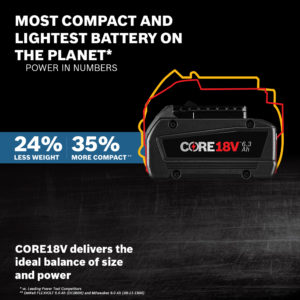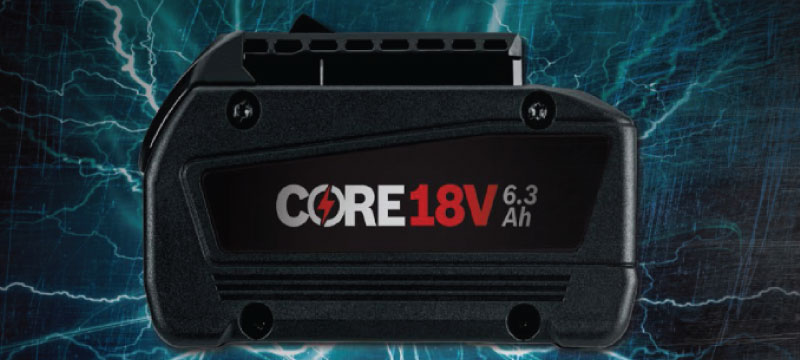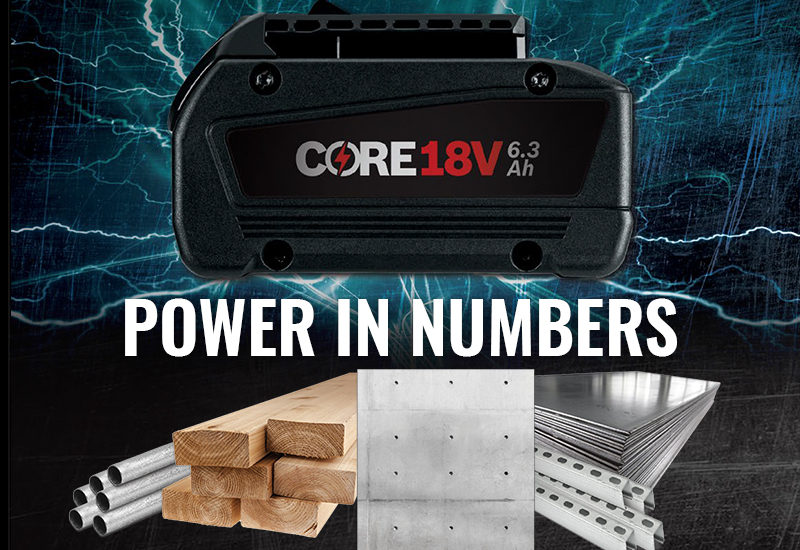Construction and trade pros know power tools intuitively; it’s second nature. However, the march towards advanced technology brings new ideas, and there is a need for a revised mindset. You must think, “I’m not really buying a power tool; I’m buying a battery platform.” The Bosch CORE18V Battery is just that type of battery to build a platform around.
In the Beginning
Ni-Cad technology was the foundation of the cordless revolution. Since then, it has been surpassed by Lithium-ion in performance. These Bosch batteries are more compact, lightweight, and offer more power compared to its Ni-Cad counterpart. In fact, Lithium-ion makes it possible to get the same 18-volt power in its smaller battery platform. With all the advantages of being lightweight and still retaining all the power, a trade pro would appreciate this.

But don’t let the talk of small size fool you; it is a consistent delivery of power. For example, a Lithium-ion battery delivers nearly complete control from when it’s charged until it’s almost drained. Not to mention that these batteries charge fast! The Bosh CORE18V battery can charge 80 percent in just 41 minutes from the complete depletion.
A tool’s voltage equates to the power of its motor; the higher the voltage, the more power there will be available. Since the development of Lithium-ion technology, 18-volt tools have come to deliver the performance construction and trade pros expect. Becoming an industry standard at a size and weight, they’re comfortable working with. If you need to remain flexible, most manufacturers are heavily invested in 18-volt tools, so you will find one that will fit you.
This is important for more arduous drilling and fastening applications, but it’s not always required. If you’re an electrician or similar trade pros working in tight places, the NEW 12-volt tool would be for you. Though they don’t have all the power of the 18-volt, it has the benefit of a much smaller footprint.
Know How It Works
Though not wrong, manufacturers report the voltages of their batteries in different ways. For example, the moment a battery is removed from the charger, the voltage of the battery will measure 20 volts. However, when the battery is attached to a tool, the voltage drops to a nominal voltage of about 18.6 volts. The tool then operates at a consistent voltage until the trigger is released, which is 18 volts. Most manufacturers will report the operating voltage, while others report the “No Load” voltage. Though both aren’t wrong in doing so. This is why you will find both 18-volt and 20-volt tools and batteries available.
As mentioned earlier, the voltage indicates the power tool motor size. The amp-hour (Ah) rating means the size of the gas tank; the higher the rating, the bigger the gas tank. Consider a 4.0 Ah versus a 2.0 Ah 18-volt battery. The 4.0 Ah battery can provide consistent 18-volt power twice as long as a 2.0 Ah option when doing similar tasks with the same tools. For small tasks, the low-amp-hour battery can do the job. But for big tasks, the higher amp-hour-rated battery is the best choice.
Look for the Best Battery Features
A fuel gauge seems like a nice-to-have option until you find out the job is on the roof of a high-rise building and the battery in hand is dead. A simple indicator helps the user assess and plan power needs in this situation.

Another issue is that heat is created as a battery discharges energy as the tool is being used. Excessive heat from the battery can hurt the tool’s performance and lifespan. The best-built batteries are made with heat dissipation in mind. Bosch batteries, for example, incorporate CoolPack technology, a proprietary battery frame design that increases airflow around the battery cells to enhance cooling.
Finally, tools and batteries need to talk. You need to communicate with your coworkers to get a job done, and so do your tools. The most innovative power tools include electronics in both the tool and battery, which communicate with each other to manage power discharge and overall performance. Innovative systems improve on-the-job performance and protect the tool and batteries while extending product life.
Summary
There are many variables to consider in a cordless tool purchase, not the least of which is the battery platform. Making a final call about power tool purchase should be about the long-term goals for your business, your trade, or how you expect to address projects that require power tools. That’s a more extensive thought process than, “What tool do I need right now?” It could be a decades-long purchase you’re making, so take your time.



